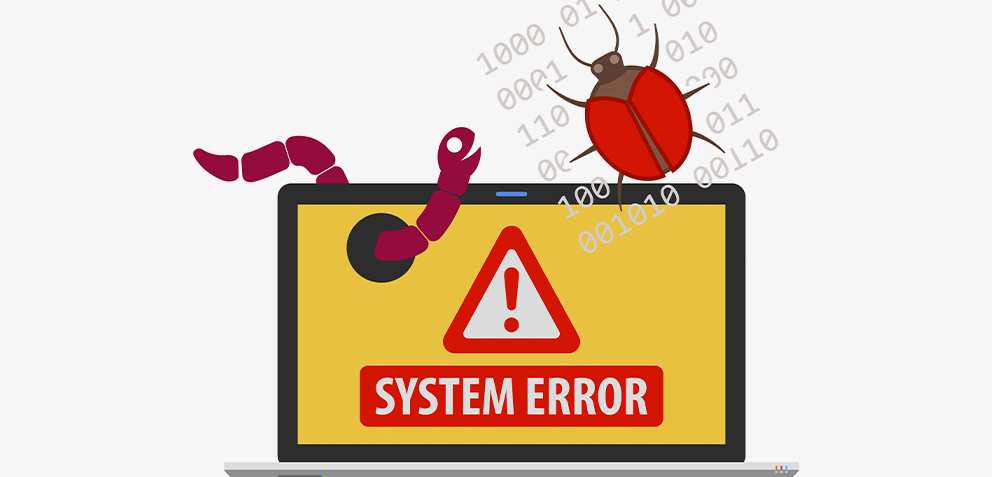
Understanding Computer Worms: Best Ways to Shield Your Data
January 14,2025
7 mins
Understanding Computer Worms: Best Ways to Shield Your Data
Cybersecurity threats are everywhere, and computer worms are among the most insidious. These self-replicating programs can spread like wildfire, causing damage to devices, networks, and data.
But what exactly is a computer worm, and how can you protect your devices from this digital security threat?
Let’s dive in to explore the answers.
| Table of Contents!
What is a Computer Worm? How Do Computer Worms Work? What Are the Types of Computer Worms? How Can Computer Worms Spread? Examples of Infamous Computer Worms How to Recognize Computer Worms How to Remove Computer Worms How AVP Suite Can Protect Your Devices Final Thoughts |
What is a Computer Worm?
A computer worm or malicious program is a form of malware that spreads throughout networks and gadgets without any human intervention. Unlike a trojan horse, which requires the user to execute the malicious code, worms duplicate or recreate themselves routinely, exploiting vulnerabilities in systems or networks.
Their goal? To disrupt systems, steal data, or pave the way for further cyberattacks.
How Do Computer Worms Work?
Detecting a computer worm early is essential to mitigate damage. Look for these warning signs:
- Infecting a Device: The worm enters through vulnerabilities in software, phishing emails, or infected files.
- Self-Replication: Unlike other forms of malware, worms recreate themselves routinely.
- Spreading Across Networks: They exploit vulnerable security in related devices to contaminate multiple systems.
- Delivering Payloads: Some worms convey additional malicious code, which includes ransomware or adware, for similar harm.
Related Read: How to Prevent Ransomware Attacks and Protect Your Online Data
What Are the Types of Computer Worms?
- Email Worms: Spread through email attachments.
- File-Sharing Worms: Propagate via shared files on networks or P2P platforms.
- Internet Worms: Exploit vulnerabilities in internet protocols.
- Network Worms: Target network devices like routers or printers.
How Can Computer Worms Spread?
This is how computer worms spread and infect your devices:
- Email Attachments: Clicking on a malicious link or document infects the device.
- Network Vulnerabilities: Worms make the most vulnerable to firewalls or previous systems.
- USB Devices: Certainly, plugging an inflamed USB drive into multiple computers can spread the bug.
- Infected Websites: Simply visiting a compromised or unsafe website can make your system vulnerable to worm exposure.
Examples of Infamous Computer Worms
Over the years, multiple strong worms have attacked millions of devices regardless of the region. However, knowing how worms spread or how to prevent them can save your devices from notorious computer worms effectively.
Let’s have a look at some of the mention-worthy computer worms examples:
1. The Morris Worm (1988)
- First Detected: November 1988
- Impact: Infected 10% of the internet (6,000 computers at the time).
- Significance: Marked the birth of cybersecurity legislation in the U.S.
2. ILOVEYOU Worm (2000)
- First Detected: May 2000
- Impact: Spread to over 10 million computers, causing $10 billion in damages.
- How: Disguised as a love letter email attachment.
3. WannaCry (2017)
- First Detected: May 2017
- Impact: Affected 200,000 devices in 150 countries within a few days.
- How: Targeted unpatched Windows systems with ransomware.
Read More: Ultimate Guide to Botnet Attacks and Data Protection
How to Recognize Computer Worms
When your device is down with a worm, there are numerous key symptoms that you shouldn’t miss out on. So, monitor your devices attentively and check if your computer has got any of these signs.
These caution symptoms allow you to quickly discover the trouble and take quick yet effective solutions to defend your data and devices:
- Sluggish Device Performance: Worms consume a lot of system sources, making the devices slow down considerably.
- Unexpected System Crashes: Frequent crashes or blue screens can also be your go-to signs of a bug affecting your operating systems.
- Increased Network Traffic: Worms regularly spread across networks, inflicting unusually excessive data usage.
- Unusual Pop-ups or Error Messages: Persistent error messages or pop-ups might be signs and symptoms of a computer worm’s presence.
- Disappearing or Corrupted Files: Worms can delete or adjust crucial documents without warning and your best knowledge. So, do check your devices to see if there are any missing files.
- Unauthorized Access Attempts: A worm may be at work if you notice unknown devices or accounts accessing your network.
- Antivirus Alerts: Warnings from your antivirus software about suspicious activities could point to a worm infection.
| Is Your Device Safe from Computer Worms?
AVP Suite blocks them before they infect your devices and compromise your security Try AVP Suite for Free! |
How to Remove Computer Worms
If you suspect your device is inflamed with a computer worm, performing quickly is crucial. Here’s what you may do to dispose of worms out of your system:
- Disconnect from the Internet: The first thing is first. You should disconnect your devices from the internet immediately. This will prevent the worm from spreading further or sending vital data to attackers.
- Run a Full System Scan: Use trusted malware protection with an antivirus solution, such as AVP Total Security, to run a thorough system scan. This can help detect and quarantine the worm from your device.
- Delete Infected Files: Once your antivirus identifies the computer virus, comply with the prompts to delete or separate inflamed documents. This prevents the bug from causing greater harm.
- Update Your Operating System and Software: Ensure your operating system and software are up-to-date. Security patches frequently work on vulnerabilities that worms make the most to enter your system inside the first place.
- Reinstall Operating System (if necessary): If the contamination is extreme and your antivirus can not eliminate the bug, you may need to reinstall your operating system. This ensures that all traces of the worm are entirely erased.
- Restore from Backup: If you’ve been backing up your files, you can restore your system to a previous, uninfected state. Ensure that your backup was created before the infection occurred.
Also Read: Adware 101: How AVP Suite Browser Extension Shields Data
How AVP Suite Can Protect Your Devices
AVP Suite offers complete safety against computer worms and other forms of malware. Integrating AVP Total Security into your device offers you a massive range of effective tools designed to save you and get rid of threats. Here’s how AVP Suite can keep your gadgets safe:
- Real-Time Malware Detection
AVP Suite gives real-time malware protection, which means it scans your devices constantly, actively detecting and blocking worms and different malware before they can cause damage.
- Advanced Antivirus Protection
AVP Suite includes robust antivirus protection, ensuring that trojans, spyware, and computer worms are blocked in real-time. It also scans and removes harmful files from your device, keeping your system safe.
- Regular Updates for Latest Protection
AVP Total Security updates its virus definitions as worms and other threats evolve. These updates ensure your antivirus software is always equipped to handle the latest digital security threats.
- Proactive Threat Prevention
In addition to removing worms, AVP Suite helps prevent infections from occurring in the first place by identifying vulnerabilities and securing your system before worms can exploit them.
- Comprehensive Data Protection
Your sensitive data is safe with AVP Total Security. With data encryption and privacy protection features, AVP Suite ensures that worms can’t access or steal your valuable information.
Final Thoughts
Computer worms are a serious cybersecurity threat, but understanding how they work and how to combat them can help you stay protected. You can secure your devices and data from harm by staying vigilant, keeping your software updated, and investing in comprehensive malware protection like AVP Total Security.
Don’t wait for a worm to disrupt your life—act now and fortify your digital defenses!
Cybersecurity threats are everywhere, and computer worms are among the most insidious. These self-replicating programs can spread like wildfire, causing damage to devices, networks, and data.
But what exactly is a computer worm, and how can you protect your devices from this digital security threat?
Let’s dive in to explore the answers.
What is a Computer Worm?
A computer worm or malicious program is a form of malware that spreads throughout networks and gadgets without any human intervention. Unlike a trojan horse, which requires the user to execute the malicious code, worms duplicate or recreate themselves routinely, exploiting vulnerabilities in systems or networks.
Their goal? To disrupt systems, steal data, or pave the way for further cyberattacks.
How Do Computer Worms Work?
Detecting a computer worm early is essential to mitigate damage. Look for these warning signs:
- Infecting a Device: The worm enters through vulnerabilities in software, phishing emails, or infected files.
- Self-Replication: Unlike other forms of malware, worms recreate themselves routinely.
- Spreading Across Networks: They exploit vulnerable security in related devices to contaminate multiple systems.
- Delivering Payloads: Some worms convey additional malicious code, which includes ransomware or adware, for similar harm.
Related Read: How to Prevent Ransomware Attacks and Protect Your Online Data
What Are the Types of Computer Worms?
- Email Worms: Spread through email attachments.
- File-Sharing Worms: Propagate via shared files on networks or P2P platforms.
- Internet Worms: Exploit vulnerabilities in internet protocols.
- Network Worms: Target network devices like routers or printers.
How Can Computer Worms Spread?
This is how computer worms spread and infect your devices:
- Email Attachments: Clicking on a malicious link or document infects the device.
- Network Vulnerabilities: Worms make the most vulnerable to firewalls or previous systems.
- USB Devices: Certainly, plugging an inflamed USB drive into multiple computers can spread the bug.
- Infected Websites: Simply visiting a compromised or unsafe website can make your system vulnerable to worm exposure.
Examples of Infamous Computer Worms
Over the years, multiple strong worms have attacked millions of devices regardless of the region. However, knowing how worms spread or how to prevent them can save your devices from notorious computer worms effectively.
Let’s have a look at some of the mention-worthy computer worms examples:
1. The Morris Worm (1988)
- First Detected: November 1988
- Impact: Infected 10% of the internet (6,000 computers at the time).
- Significance: Marked the birth of cybersecurity legislation in the U.S.
2. ILOVEYOU Worm (2000)
- First Detected: May 2000
- Impact: Spread to over 10 million computers, causing $10 billion in damages.
- How: Disguised as a love letter email attachment.
3. WannaCry (2017)
- First Detected: May 2017
- Impact: Affected 200,000 devices in 150 countries within a few days.
- How: Targeted unpatched Windows systems with ransomware.
Read More: Ultimate Guide to Botnet Attacks and Data Protection
How to Recognize Computer Worms
When your device is down with a worm, there are numerous key symptoms that you shouldn’t miss out on. So, monitor your devices attentively and check if your computer has got any of these signs.
These caution symptoms allow you to quickly discover the trouble and take quick yet effective solutions to defend your data and devices:
- Sluggish Device Performance: Worms consume a lot of system sources, making the devices slow down considerably.
- Unexpected System Crashes: Frequent crashes or blue screens can also be your go-to signs of a bug affecting your operating systems.
- Increased Network Traffic: Worms regularly spread across networks, inflicting unusually excessive data usage.
- Unusual Pop-ups or Error Messages: Persistent error messages or pop-ups might be signs and symptoms of a computer worm’s presence.
- Disappearing or Corrupted Files: Worms can delete or adjust crucial documents without warning and your best knowledge. So, do check your devices to see if there are any missing files.
- Unauthorized Access Attempts: A worm may be at work if you notice unknown devices or accounts accessing your network.
- Antivirus Alerts: Warnings from your antivirus software about suspicious activities could point to a worm infection.
Is Your Device Safe from Computer Worms?
AVP Suite blocks them before they infect your devices and compromise your security
Try AVP Suite for Free!
How to Remove Computer Worms
If you suspect your device is inflamed with a computer worm, performing quickly is crucial. Here’s what you may do to dispose of worms out of your system:
- Disconnect from the Internet: The first thing is first. You should disconnect your devices from the internet immediately. This will prevent the worm from spreading further or sending vital data to attackers.
- Run a Full System Scan: Use trusted malware protection with an antivirus solution, such as AVP Total Security, to run a thorough system scan. This can help detect and quarantine the worm from your device.
- Delete Infected Files: Once your antivirus identifies the computer virus, comply with the prompts to delete or separate inflamed documents. This prevents the bug from causing greater harm.
- Update Your Operating System and Software: Ensure your operating system and software are up-to-date. Security patches frequently work on vulnerabilities that worms make the most to enter your system inside the first place.
- Reinstall Operating System (if necessary): If the contamination is extreme and your antivirus can not eliminate the bug, you may need to reinstall your operating system. This ensures that all traces of the worm are entirely erased.
- Restore from Backup: If you’ve been backing up your files, you can restore your system to a previous, uninfected state. Ensure that your backup was created before the infection occurred.
Also Read: Adware 101: How AVP Suite Browser Extension Shields Data
How AVP Suite Can Protect Your Devices
AVP Suite offers complete safety against computer worms and other forms of malware. Integrating AVP Total Security into your device offers you a massive range of effective tools designed to save you and get rid of threats. Here’s how AVP Suite can keep your gadgets safe:
1. Real-Time Malware Detection
AVP Suite gives real-time malware protection, which means it scans your devices constantly, actively detecting and blocking worms and different malware before they can cause damage.
2. Advanced Antivirus Protection
AVP Suite includes robust antivirus protection, ensuring that trojans, spyware, and computer worms are blocked in real-time. It also scans and removes harmful files from your device, keeping your system safe.
3. Regular Updates for Latest Protection
AVP Total Security updates its virus definitions as worms and other threats evolve. These updates ensure your antivirus software is always equipped to handle the latest digital security threats.
4. Proactive Threat Prevention
In addition to removing worms, AVP Suite helps prevent infections from occurring in the first place by identifying vulnerabilities and securing your system before worms can exploit them.
5.Comprehensive Data Protection
Your sensitive data is safe with AVP Total Security. With data encryption and privacy protection features, AVP Suite ensures that worms can’t access or steal your valuable information.
Final Thoughts
Computer worms are a serious cybersecurity threat, but understanding how they work and how to combat them can help you stay protected. You can secure your devices and data from harm by staying vigilant, keeping your software updated, and investing in comprehensive malware protection like AVP Total Security.
Don’t wait for a worm to disrupt your life—act now and fortify your digital defenses!
AVP Suite shields your devices against worms 24/7
Claim Your Free Trial!





